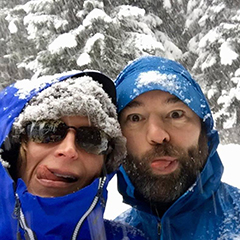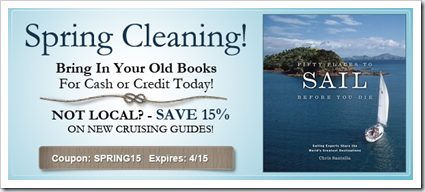I’ve been reading The Cruiser’s Handbook of Fishing by Scott Bannerot
and it’s very thorough if not too thorough. He does a great job for
recommending specific gear for every open ocean and dinghy based kind of
fishing a cruiser might want to do. In fact there are so many
recommendations that it’s a lot to take in. There are several charts in
the book with gear recommendations and prices (as of 2009) that I put
into a spread sheet and the total was over \$3500 !!
I don’t think it was Scott’s intention for someone to buy everything he
recommends but instead to have the reader understand what kind of
fishing they want to do, what kind of fish they want to target and then
to pick from his recommendations. That’s a pretty tall order for a new
fisherman who will be fishing in unfamiliar waters. However, narrow it
down we must and make some educated guesses we will.
I am approaching these open ended “things” by trying to be aware and
open about my assumptions, evaluating them as we learn more and trying
to make the best decision we can. In this case, I believe that mostly we
want to troll while we’re sailing with an unattended line and we want to
do so in a reliable way that is likely to be most productive and with
the least amount of lost gear and fish. I also do not want to have to
deal with live bait on a regular basis and will limit it’s use as an
occasional opportunistic endeavor. I’m now going to babble on a bit
about these configurations and what I’ve learned thus far.
In my opinion that rules out handline fishing from yo-yo’s with snubbers
and standup rigs. While underway a standup rig would require leaving the
cockpit to get out from under the stainless steel structure of the
bimini as well as the mizzen boom. Based on Bannerot’s recommendations
it leaves us with the option of the Alvey 1225 Reef Master Deck
Winch, a rail
mounted reel such as the Penn Senator
116
or a wire-line rodreel setup like the Penn/Captain Harry’s Combo (Penn
Senator
115).
The Alvey appears to be a very solid piece of gear with few moving parts
to break or maintain. It’s manufactured in Australia and would be a
special order item from Alvey USA, they are
not stocked anywhere in the US.
The Penn Senator 116 seems like a reasonable alternative to the Alvey
albeit with more parts and potentially maintenance issues. It has the
added advantage of also being rod mountable and thus dual purpose. On
the downside it also “looks valuable” as compared to the Alvey and in
port would definitely need to be stowedhidden.
Bannerot gives rave reviews to wire-line rigs basically calling it his
go-to setup
Wire line represents the simplest, most direct way to troll lures and
baits deep, enabling you to wreak havoc on wahoo, tuna, mackerel,
jack, grouper, snapper and many others offshore, inshore and near
reefs, wrecks, and seamounts. It’s simple to use–no setting the hook,
no removal from the rod holder, no belt and harness—all you do is
crank the reel handle whenever the fish is not taking line off the
spool until you get it boatside. … Shortcomings of trolling wire line
are that it is generally not as effective for mahi mahi, and it may
not handle the really big ones, especially larger bill fish. But when
we need a good eating fish, particularly nearing port or some
significant fish-producing area, we often deploy only the wire line
because of its effectiveness. – Bannerot
Based on that alone I feel like the Penn/Captain Harry’s Combo (Penn
Senator
115)
upgraded to have monel wire might be the trolling rig I start with.
The Alvey and the wire line rig have the benefit of getting the line out
away from the stern a bit before it leads down to the water. The
windvane which will be on the stern may also pose issues here. That
alone may require a release clip to get the wire over or around the
windvane (more of an issue with the Monitor jungle gym than the
Hydrovane). A release clip is basically a fairlead for the line which
opens up when a fish strikes. Aftco seems to be
the main manufacturer.
Still a lot to think on and more fun reading to do, luckily there is no
time criticalness to these decisions we can get this gear whenever we
feel like it. Let me know if you have any suggestions or additional
thoughts in the comments.

